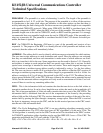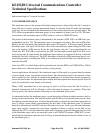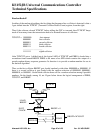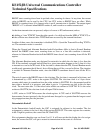
KS152JB Universal Communications Controller
Technical Specifications
Kawasaki LSI USA, Inc. Page 41 of 120 Ver. 0.9 KS152JB2
3.2.4 CSMA/CD DATA ENCODING
Manchester encoding/decoding is automatically selected when the user software selects CSMA/
CD transmission mode (See Figure below). In Manchester encoding the value of the bit is deter-
mined by the transition in the middle of the bit time, a positive transition is decoded as a 1 and a
negative transition is decoded as a 0. The Address and Info bytes are transmitted LSB first. The
CRC is transmitted MSB first.
If the external 1X clock feature is chosen the transmission ode is always NRZ (see Section
3.5.11). Using CSMA/CD with the external clock option is not supported because the data needs
reformatting from NRZ to Manchester for the receiver to be able to detect code violations and col-
lisions.
3.2.5 COLLISION DETECTION
The GSC hardware detects collisions by detecting Manchester waveform violations at its GRXD
pin. Three kinds of waveform violations are detected: a missing 0-to-1 transition where one was
expected, a 1-to-0 transition where none was expected, and a waveform that stays low (or high)
for too short a time.
Jitter Tolerance
A valid Manchester waveform must have a transition at the midpoint of any bit cell, and may have
a transition at the edge of any bit cell. Therefore, transitions will nominally be separated by either
1/2 bit-time or 1 bit-time.
The GSC samples the GRXD pin at the rate of 8 x the bit rate. The sequence of samples for the
received bit sequence 001 would nominally be:
samples: 11110000 : 11110000 : 00001111 :
bit value: 0 : 0 : 1 :
:<-bit cell->: <-bit cell->: <-bit cell->:
The sampling system allows a jitter tolerance of
+ 1 sample for transitions that are 1/2 bit-time
apart, and
+2 samples for transitions that are 1 bit-time apart.
01 1 0 01
MANCHESTER ENCODING
BIT
TIME


















